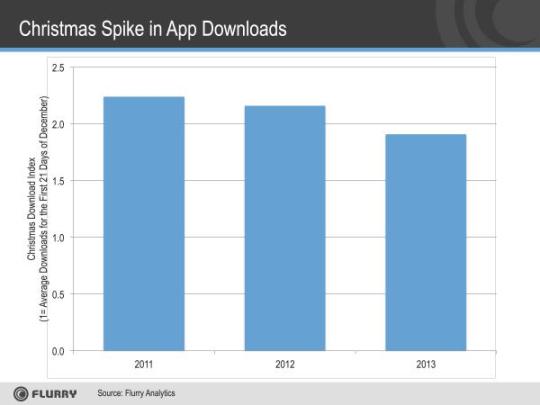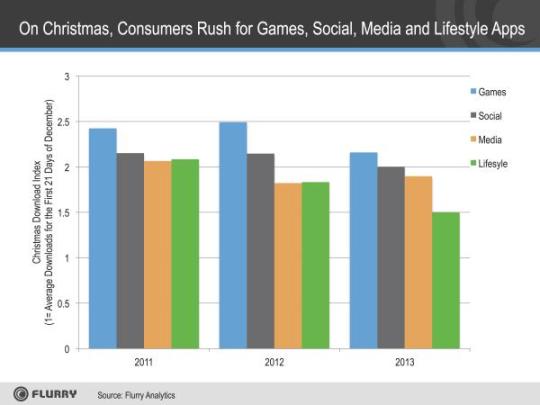December 30, 2013 | Mary Ellen Gordon, PhD
As we said in previous posts, connected devices have become part of our Christmas andThanksgiving traditions. This marks a change from just a few years ago when smartphones and tablets represented exciting new additions to our lives that we couldn’t wait to unwrap, activate, and start filling up with apps.
Flurry’s data showed another record-breaking level of app downloads this Christmas, but it also provides further evidence that, in the early mobile markets at least, devices are evolving from being our new shiny toys to our everyday companions.
For this report, we looked across more than 400,000 apps that Flurry tracks globally to see what happened around the Christmas tree. We found that Christmas downloads were up by 91% compared to an average day in the first three weeks of December. That is a large increase, but as shown below, the size of the Christmas download spike is diminishing over time as the app market matures and globalizes.

2013 was the biggest Christmas yet for mobile app downloads. As the chart below shows, overall app downloads increased by 11% on Christmas 2013 compared to Christmas 2012. Over the same one year time span, there was a 25% increase in app downloads on an average December day. As the data illustrates, both the overall rate of year-on-year growth and the year-on-year Christmas growth have slowed considerably in the past year (from 97% and 90% respectively between 2011 and 2012).

The slowing growth rates and smaller Christmas Day app download spike signal market maturation. Many consumers in Western Europe and English-speaking countries – large mobile markets where Christmas is a big holiday – already have a smartphone and / or a tablet. Fewer people are coming online with mobile for the very first time. Consumers who are on second, third or fourth devices have apps that they like and trust, and while they still download new apps, there isn’t much more impetus to do so on Christmas than any other day when they have a little downtime. New device activations do still spike on Christmas, but that spike is waning compared to years past, and it comes on top of a much larger installed base. That means that when new devices are loaded with apps, the overall impact on app download volume is not as big.
The biggest growth in mobile now is coming in countries where Christmas is a less significant holiday or not celebrated at all, so new device activations and app downloads come at different times of the year in those places. And because those high-growth areas are joining an already large global market, overall growth rates are less striking than when the mobile market was new.
To look at the types of apps that see the greatest increase in downloads at Christmas, we indexed the numbers by comparing Christmas to an average day in the first three weeks of December to eliminate inflation due to the continued growth of the overall connected device installed base.
After doing that, we see a similar phenomenon to what happened on Thanksgiving. Because our devices have become so intertwined with our lives, on a day like Christmas when most of us are relaxing, the apps we download reflect that. Games and social apps were downloaded on Christmas at twice the rate they were on a typical December day. The other categories that experienced the largest surge in Christmas downloads were media (photo, video, music) and lifestyle (sports, books, magazines, entertainment).

Maturation of the app market means that changes are in store for app developers. The gold rush days of huge jumps in the overall size of the connected device installed base on Christmas, followed by a dizzying rush of app downloads are fading. Of course, there will still be apps that tap into some vein of consumer interest or amusement and developers who strike it rich as a consequence. But overall, the successful developers in 2014 and beyond will be those who put in the hard work of identifying a target group of users, creating apps that work well for them, and continually refining and reinventing mobile experiences to profitably retain those users. We’ll talk more about that in early 2014.